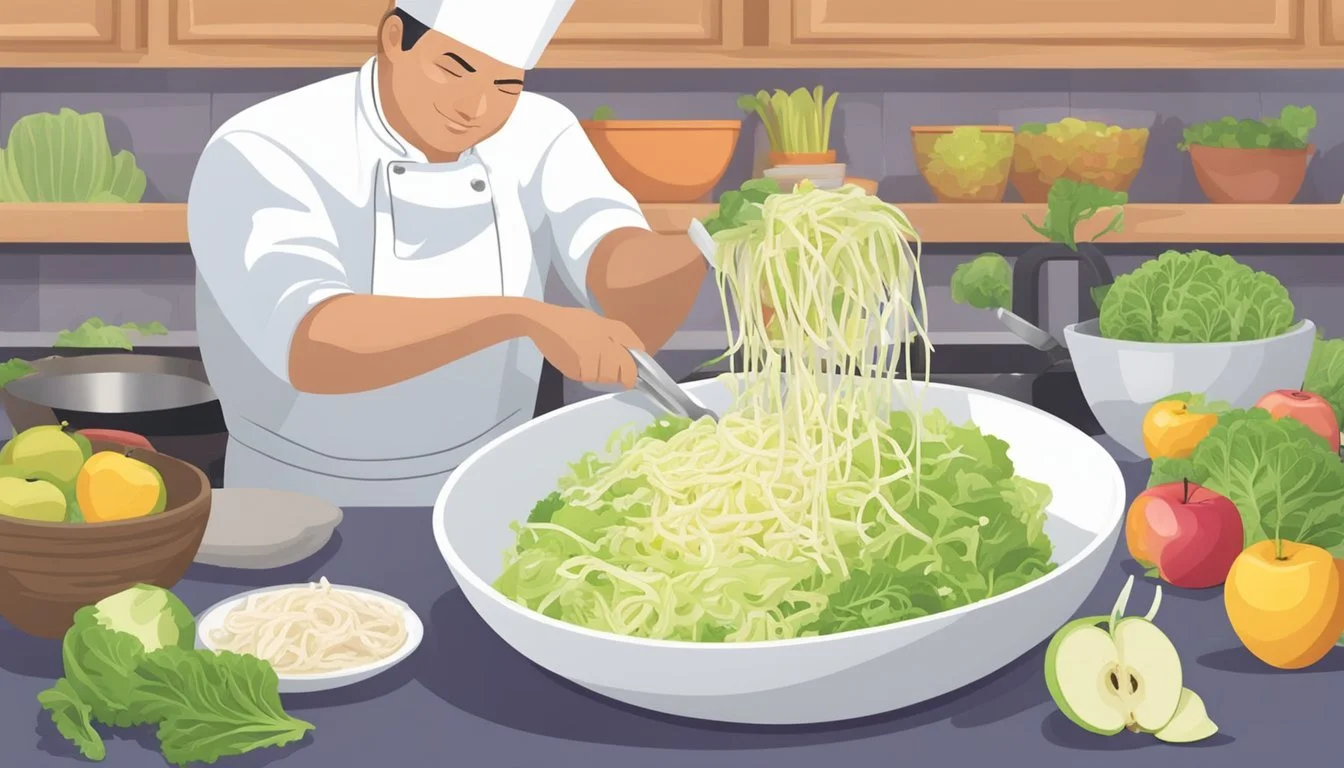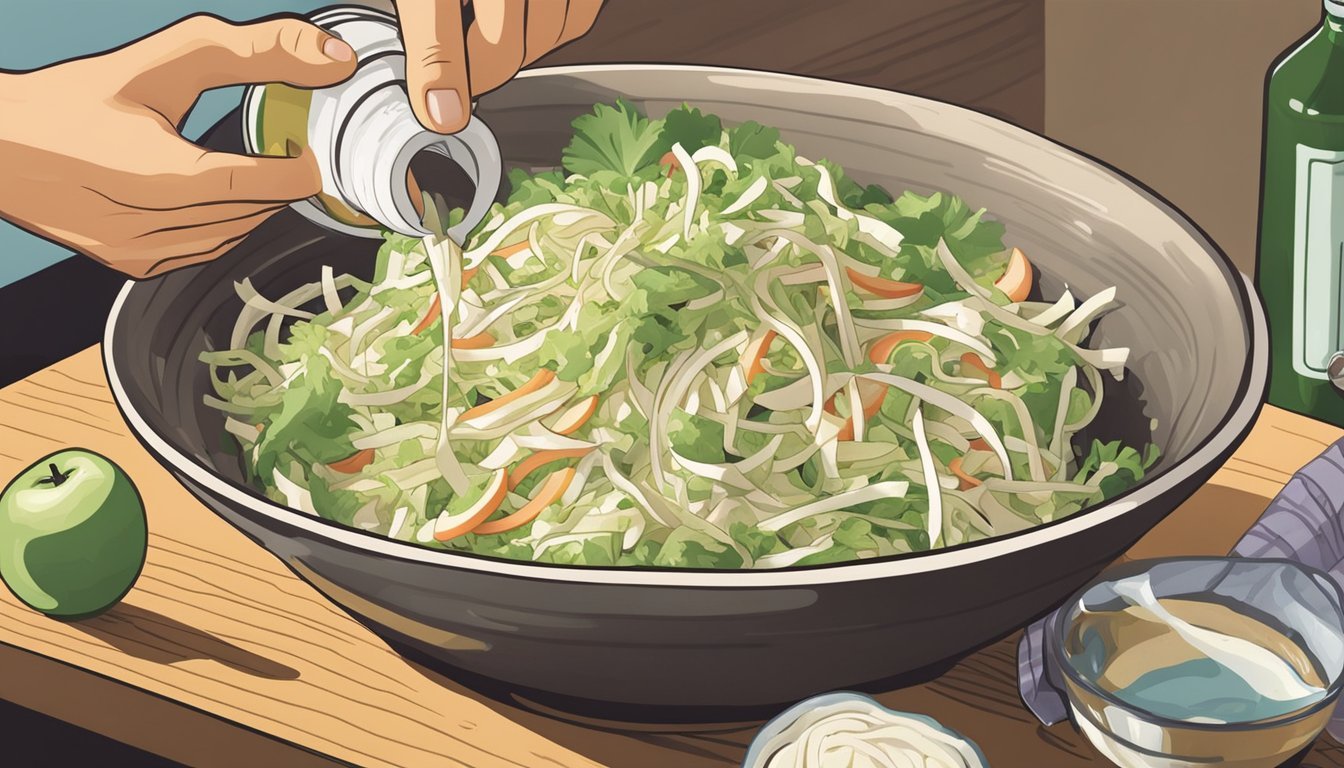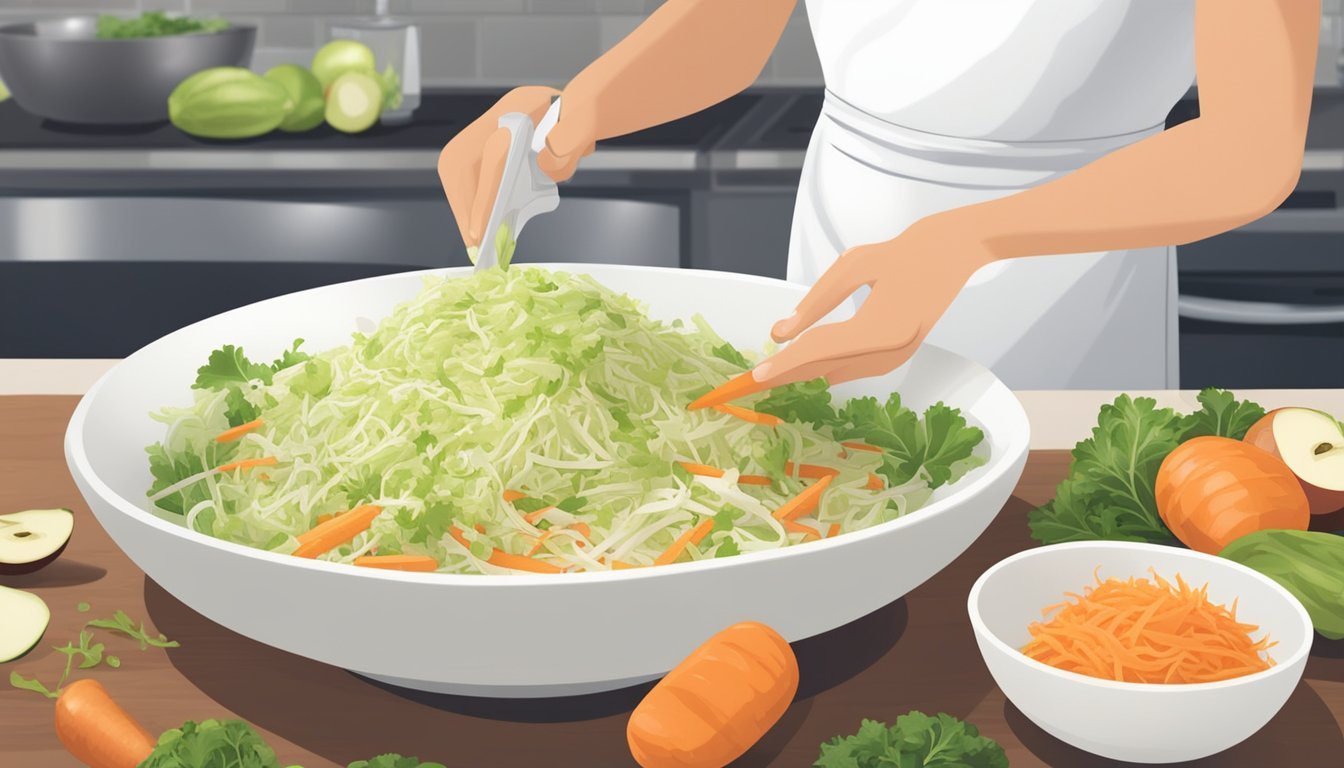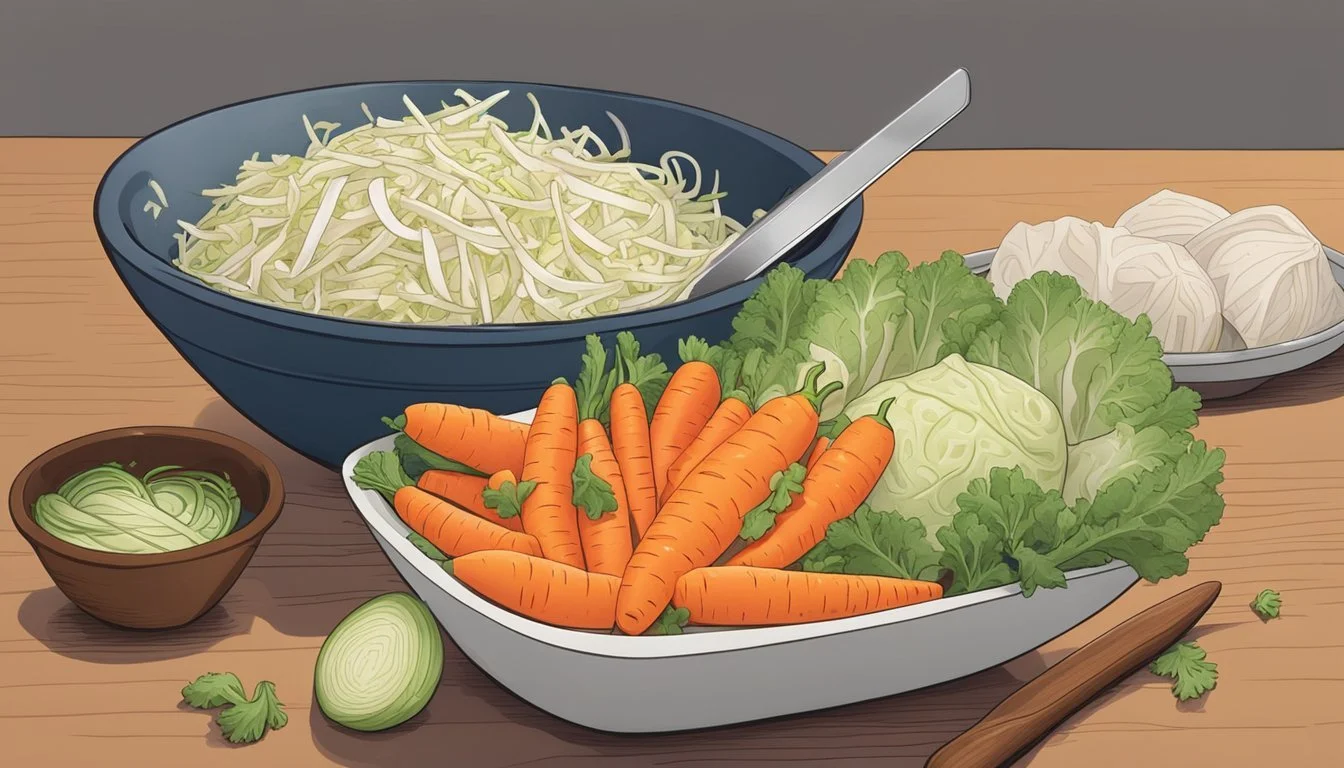How to Substitute Jicama for Apples in Slaw
A Fresh Twist on a Classic Side
In the versatile world of slaws, the crisp texture and subtle sweetness of apples (how long do apples last?) are often prized for the freshness they bring to the dish. However, when it comes to substituting apples, jicama stands out as a remarkable alternative. This root vegetable native to Mexico, with its unique white flesh and fibrous texture, provides a similar crunch and a mildly sweet flavor that complements the tangy dressing of a slaw.
When using jicama as a replacement for apples in slaw recipes, it is important to consider how it merges with the other ingredients. Its ability to absorb flavors makes jicama an excellent conduit for the zesty and savory components typically found in slaw dressings. Moreover, jicama's durability in texture ensures that it remains crisp even after being dressed, a quality highly desirable in slaw preparations.
Understanding Jicama
Jicama is a root vegetable known for its versatile culinary applications and nutritional benefits. The following subsections provide detailed insights into what jicama is and its nutritional profile.
What Is Jicama?
Jicama (Pachyrhizus erosus) is a tuberous root vegetable native to Mexico and South America, often called a Mexican turnip or yam bean. Characterized by its crunchy texture and mild flavor, jicama has become a popular ingredient in salads and slaws. The starchy root is typically consumed raw, retaining its crunchy texture that works well as an apple substitute in slaws.
Nutritional Profile of Jicama
Jicama is not only low in calories but also an excellent source of dietary fiber, which is beneficial for digestion. In terms of nutrition, jicama provides a good amount of vitamin C, essential for immune system health and skin integrity.
Nutrient Amount per 100g Calories 38 kcal Protein 0.72 g Total Fat 0.09 g Carbohydrate 8.82 g Fiber 4.9 g Sugar 1.80 g Sodium 4 mg Potassium 150 mg Vitamin C 20.2 mg
Jicama is low in sodium and has a negligible amount of fat, making it an appealing ingredient for health-conscious individuals. Its sugar content is moderate, providing a hint of sweetness without overwhelming the palate. The presence of potassium aids in maintaining fluid balance and proper muscle function.
Preparing the Jicama
Before incorporating jicama as a substitute for apples in slaw, it is crucial to prepare it properly to ensure the right texture and flavor. This process involves selecting a fresh jicama, thoroughly cleaning it, and then cutting it into the desired matchstick-sized pieces.
Selecting the Right Jicama
One should choose a jicama that is firm and free of blemishes. The skin should be dry and the root vegetable as a whole should feel heavy for its size, indicating freshness. Smaller jicama tend to be juicier and sweeter, which makes them an ideal candidate for slaw.
Washing and Peeling Jicama
Jicama must be washed under cool, running water to remove any dirt. After patting it dry, one needs to peel it using a vegetable peeler or a sharp knife to remove the fibrous brown skin, which is inedible and tough.
Cutting Jicama into Matchsticks
To replicate the texture of apples in slaw, jicama should be sliced into thin matchstick-sized pieces. This can be achieved by:
Cutting the peeled jicama into thin rounds.
Stacking the rounds and slicing them into thin strips. If time is a constraint or for added convenience, one can opt for pre-cut jicama sticks available at some grocery stores. However, fresh jicama cut at home may provide a better texture and flavor for the slaw.
Creating the Slaw Base
In a slaw, the base sets the stage for flavor combinations and texture contrasts. Careful selection and combination of vegetables ensure a crisp and satisfying foundation for the dish.
Choosing Slaw Ingredients
When creating a slaw base, one should prioritize crunchy and fresh ingredients. Cabbage is the cornerstone of slaw, and there are several varieties to choose from.
Green cabbage is classic with a crisp texture and peppery flavor.
Napa cabbage offers a milder taste and a more tender bite.
Carrots add a hint of sweetness and a vibrant color. Choosing fresh, firm carrots will contribute to the desired crunchiness of the slaw.
Combining Cabbage and Carrots
Combining cabbage and carrots is effortless:
Shred the chosen type of cabbage uniformly for consistency in bite and appearance.
Peel and grate carrots to match the size of the shredded cabbage.
A julienne peeler or a food processor with a shredding attachment can efficiently process these vegetables. Mixing them in a large bowl with a drizzle of olive oil can help in slightly softening the vegetables and integrating the flavors.
Incorporating Additional Vegetables
For a versatile slaw base, additional vegetables can be added for complexity and flavor:
Thinly sliced onion or green onion adds a sharp, aromatic edge.
Diced celery (how long does celery last?) contributes a subtle bitterness and additional crunch.
Radish can be incorporated for a peppery zing and color contrast.
All vegetables should be cut to a uniform size to ensure even distribution of flavors and textures. These ingredients create a diverse and flavorful slaw base that can be customized with various dressings and additions such as jicama for a crisp and refreshing twist.
Apple Substitution in Slaw
When making slaw, the crisp texture and subtle sweetness of apples can be effectively replaced with jicama, allowing for a fresh take on traditional recipes.
Substituting Jicama for Apple
Jicama offers a crunchy texture and tangy flavor that can mimic that of green apples in slaw recipes. The root vegetable has a consistent and slightly sweet taste that complements slaw dressings well. It's particularly akin to the Granny Smith apple, which is known for its firmness and tartness. To substitute jicama for apple in slaw:
Use jicama in a 1:1 ratio to replace green apple or red apple.
Ensure the jicama is peeled and cut into matchsticks or grated, depending on the slaw recipe's requirements.
Consider the flavor profile: jicama's mild taste allows other flavors in the slaw, such as cilantro or lime juice, to stand out.
For a balanced taste that closely resembles that of slaw with apples:
Mix the jicama with ingredients that provide a slight acidity or sweetness, which is often provided by the apple in traditional recipes.
If the recipe calls for the sweeter red apple, you may add a drizzle of honey or a pinch of sugar to the slaw to match the sweetness level.
Seasoning and Dressing the Slaw
When substituting jicama for apples in slaw, carefully consider the seasonings and dressing to complement its mild flavor and crisp texture. Seasoning adjustments and the choice of dressing are pivotal to achieving a harmonious balance with this crunchy vegetable.
Salt and Pepper Adjustments
Substituting jicama for apples typically demands a reassessment of salt and black pepper levels. The natural sweetness and tartness of apples often require less seasoning, while jicama's subdued flavor might need a slight increase in salt to enhance its taste. Black pepper can be added judiciously to introduce a gentle heat that won't overpower the jicama.
Choosing the Right Dressing
Slaw dressings vary widely, but when using jicama instead of apples, it is important to opt for a dressing that binds well with its texture. Mayonnaise-based dressings offer a creamy consistency that complements the crunchy jicama, while a lighter option may include plain Greek yogurt as a tangy and healthier alternative. For those aiming for a sharper taste, apple cider vinegar serves as a flavorful acid that can brighten the slaw.
Ingredient Purpose Mayonnaise Provides creaminess Greek Yogurt Adds a tangy flavor and is a healthier option Apple Cider Vinegar Offers a sharp and bright flavor
The Role of Citrus in Slaw
The addition of citrus can elevate the slaw, especially when used with jicama. Lime juice introduces a zesty twist that melds well with jicama's crunchy properties, while lemon juice can provide a different kind of tang that's slightly more subdued. These ingredients not only offer depth of flavor but also protect the jicama from browning.
Lime Juice: Adds zest and freshness.
Lemon Juice: Provides a gentle tang and helps prevent browning.
By using these insights into seasoning and dressing, one can create a jicama slaw that's both flavorful and texturally appealing.
Enhancing the Flavor Profile
Substituting jicama for apples in slaw requires consideration of how to retain the intended flavor balance of the original recipe. The following approaches help ensure that the slaw remains a harmonious fusion of tastes and aromas even with the substitution of jicama.
Incorporating Herbs and Spices
Cilantro: This herb contributes a fresh and slight citrusy flavor to the slaw. It pairs exceptionally well with jicama, mimicking the lightness of apple-based slaws.
Mint: To add a cool and refreshing element, mint is an excellent choice. It brings a bright contrast to the jicama’s sweetness, highlighting its crisp texture.
Utilizing serrano or jalapeño peppers introduces a subtle heat that complements the mild taste of jicama. By carefully adding these herbs and spices, the flavor profile of the slaw can be significantly enhanced while embracing the unique qualities of jicama.
Balancing Sweetness and Acidity
Honey: When jicama replaces apple, the natural sweetness may be reduced. To compensate, one can introduce honey, which offers a natural and gentle sweetness without overpowering the dish.
Apple Cider Vinegar: This ingredient assists in providing the tangy kick that an apple typically would supply. It balances the sweet notes, especially when jicama is used as a substitute.
By adjusting the levels of honey and apple cider vinegar, one can fine-tune the slaw's flavor to achieve a desirable balance between sweetness and acidity, ensuring a satisfying taste experience.
Serving and Pairing Suggestions
Jicama slaw serves as a versatile side dish that can adapt to various dishes and occasions. Its crisp texture and balanced flavor profile make it an excellent alternative to traditional apple slaw.
Accompaniments for Jicama Slaw
Jicama slaw pairs well with a variety of foods. It can complement the flavors of fish tacos, adding a crunchy texture and refreshing taste that balances the richness of the fish. When served alongside barbecue dishes, the slaw's lightness serves as a palate-cleanser to the hearty, smoky flavors typically found in barbecued meats. (What wine goes well with barbecued meats?)
Fish Tacos: Add jicama slaw for a crispy dimension.
Barbecue: Serve as a refreshing side to contrast rich flavors.
Innovative Ways to Serve Jicama Slaw
There's no shortage of creative serving suggestions for jicama slaw. During summer gatherings, use it as a topping on grilled dishes (What wine goes well with grilled dishes?) or incorporate it into salads for an added crunch. Jicama slaw can also be enjoyed as a snack, perhaps substituting traditional celery sticks or apple slices with a jicama version for dipping into various sauces and dressings.
Grilled Dishes: Top with jicama slaw for a refreshing summer element.
Salads: Mix into greens for extra crunch.
Snack: Use jicama sticks for dipping into your favorite sauces or dressings.
Dietary Considerations
When substituting jicama for apples in slaw recipes, it's important for individuals adhering to specific dietary requirements to take into account the ingredients used in the substitution process. This section will focus on how to make jicama slaw both vegan and gluten-free, ensuring that the dietary needs of those sensitive to animal products and gluten are met.
Making Jicama Slaw Vegan and Gluten-Free
To ensure that the jicama slaw is vegan, one must avoid ingredients that are animal-derived. Here is a brief list of substitutes:
Yogurt: Replace dairy-based yogurt with vegan yogurt alternatives such as soy, almond, or coconut-based yogurt.
Honey: Use agave syrup, maple syrup, or other plant-based sweeteners in lieu of honey.
For a gluten-free jicama slaw, attention must be paid to any added sauces or dressings that may contain gluten. Here are some tips:
Verify that all condiments and seasonings are labeled gluten-free.
If using store-bought dressings, opt for ones that are certified gluten-free.
Consider making homemade dressing using gluten-free ingredients to have full control over the contents.
It is also essential to prevent cross-contamination if the kitchen is used to prepare gluten-containing foods. Using clean utensils and surfaces when making the slaw is a simple yet effective strategy to avoid any gluten exposure.
Storage and Shelf Life
Proper storage methods extend the shelf life of jicama slaw, ensuring it remains crisp and fresh for consumption. Attention to the environment and container used for storage can markedly affect the quality of leftover slaw.
Storing Leftover Jicama Slaw
Leftover jicama slaw should be stored in an airtight container to maintain freshness and prevent the absorption of other flavors from the refrigerator. It is imperative to refrigerate the slaw as soon as possible after serving. The typical shelf life for refrigerated jicama slaw is up to three days; however, the slaw is best enjoyed within the first 24 hours to enjoy its optimal texture and taste.
Do: Immediately refrigerate in a sealed container.
Don't: Leave slaw out at room temperature for prolonged periods.
Maximizing Freshness
To maximize the freshness of jicama slaw, one should focus on two critical aspects: humidity control and temperature. Refrigerators should be set at a consistent temperature, ideally between 35°F and 38°F (1.7°C to 3.3°C), to keep the slaw crisp. A balance in humidity is also crucial – too much can make the slaw soggy, while too little may dry it out.
Do: Use crisp drawers if available, as they provide a more controlled environment.
Don't: Store slaw beside strong-odor foods that it could absorb.
Nutritional Information
When substituting jicama for apples in slaw, one should consider the nutritional differences to ensure the dish remains balanced. Jicama offers a distinct nutrient profile compared to apples, which may affect the overall nutritional value of the slaw.
Caloric and Macronutrient Breakdown
Jicama is low in calories but high in fiber. Here is a nutritional comparison based on a 100-gram serving:
Apples:
Calories: 52
Protein: 0.26 grams
Fat: 0.17 grams
Saturated Fat: 0.028 grams
Cholesterol: 0 mg
Sugars: 10.39 grams
Fiber: 2.4 grams
Jicama:
Calories: 38
Protein: 0.72 grams
Fat: 0.09 grams
Saturated Fat: 0.02 grams
Cholesterol: 0 mg
Sugars: 1.8 grams
Fiber: 4.9 grams
Vitamins and Minerals Content
Jicama and apples both contribute valuable vitamins and minerals, differing in their specific offerings:
Apples:
Vitamin C: 4.6 mg
Vitamin A: 3 IU
Potassium: 107 mg
Calcium: 6 mg
Iron: 0.12 mg
Jicama:
Vitamin C: 20.2 mg
Vitamin A: 21 IU
Potassium: 150 mg
Calcium: 12 mg
Iron: 0.60 mg
Jicama provides a higher content of vitamin C and iron than apples, making it a nutritious substitute in slaw recipes. It is also higher in dietary fiber, which can promote digestive health. On the other hand, apples contain more sugars, which may provide a sweeter taste and a quick energy source. When making substitutions, these nutritional differences are key factors to bear in mind.











